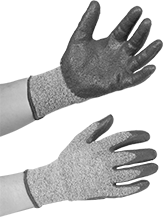About Glove Sizing
More
About Cut-Resistant Gloves
More
Coated Cut-Protection Gloves

The coating on these gloves provides extra protection and wear resistance. All meet the ANSI/ISEA 105 standard, which designates levels of cut resistance based on the force needed to cut through the material of the glove using a razor blade.
Dyneema gloves are thinner, more breathable, and more form fitting than Kevlar gloves.
Palm-coated gloves have an uncoated back side that makes the gloves more comfortable and breathable. Latex-coated gloves are water resistant.
Style A provide cut protection without hindering dexterity. They are textured to provide added grip. For a secure fit, they have a knit cuff.
Welding Gloves

Reinforced seams and fingertips prevent burn-through. Use these gloves to shield your hands from welding sparks and spatter.
Cowhide gloves balance durability and comfort.
Gloves with Kevlar threads have strengthened, flame-resistant seams.
Style B have reinforced palms and thumbs for added durability.
Welding Sleeves

Use these sleeves alone or with gloves to protect your arms. They shield your arms from welding sparks and spatter.
Cotton-and-leather sleeves shield your hand from heat and scrapes while providing cool, lightweight protection up your arm. Sleeves with goatskin leather are more lightweight, abrasion resistant, and durable than those with other leathers.
| Lg. | Cuff Style | Color | Features | Size | Pair | |
Standard | ||||||
|---|---|---|---|---|---|---|
Cotton Fabric and Goatskin Leather | ||||||
| 22" | Knit | Blue/White | Kevlar Threads | One Size | 00000000 | 000000 |

























